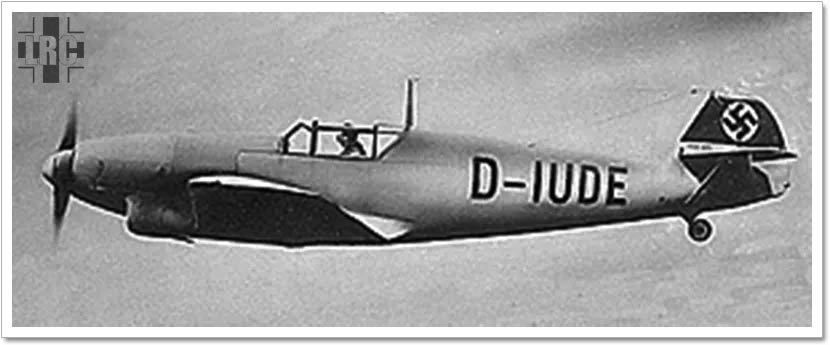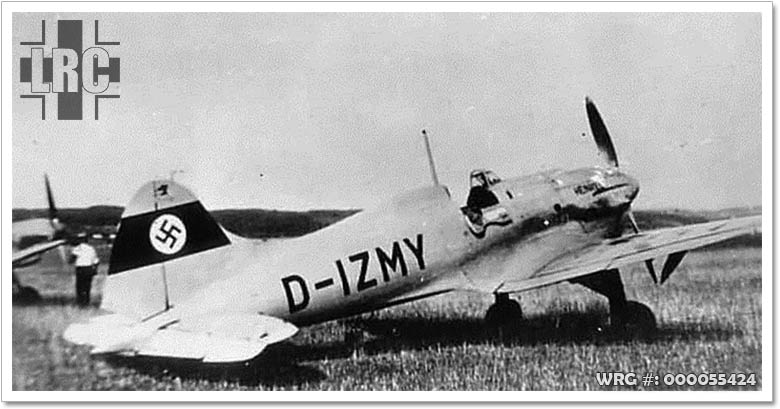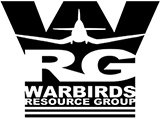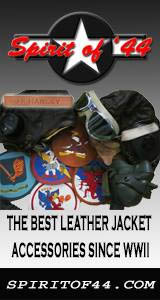Messerschmitt BF 109
Design Competition
After Luftwaffe acceptance trials were completed at their headquarters Erprobungsstelle (E-Stelle) military
aviation test and development facility at Rechlin, the prototypes were moved to the subordinate E-Stelle
Baltic seacoast facility at Travemünde for the head-to-head portion of the competition. The aircraft
participating in the trials were the Arado Ar 80 V3, the Focke-Wulf Fw 159 V3, the Heinkel He 112 V4 and the
Bf 109 V2. The He 112 arrived first, in early February 1936, followed by the rest of the prototypes by the
end of the month.

Messerschmitt Bf 109V-2/D-IUDE.
Because most fighter pilots of the Luftwaffe were used to biplanes with open cockpits, low wing loading, light
g-forces and easy handling like the Heinkel He 51, they were very critical of the Bf 109 at first. However,
it soon became one of the frontrunners in the contest, as the Arado and Focke-Wulf entries, which were
intended as "backup" programmes to safeguard against failure of the two favourites, proved to be completely
outclassed. The Arado Ar 80, with its gull wing (replaced with a straight, tapered wing on the V3)
and fixed, spatted undercarriage was overweight and underpowered, and the design was abandoned after
three prototypes had been built. The parasol winged Fw 159, potentially inspired by the same firm's
earlier Focke-Wulf Fw 56, was always considered by the E-Stelle Travemünde facility's staff to be a
compromise between a biplane and an aerodynamically more efficient, low-wing monoplane. Although it
had some advanced features, it used a novel, complex retractable main undercarriage which proved to be
unreliable.
Initially, the Bf 109 was regarded with disfavour by E-Stelle test pilots because of its steep ground angle,
which resulted in poor forward visibility when taxiing; the sideways-hinged cockpit canopy, which could not
be opened in flight; and the automatic leading edge slats on the wings which, it was thought, would
inadvertently open during aerobatics, possibly leading to crashes. This was later borne out in combat
situations and aerobatic testing by various countries' test establishments. The leading edge slats and
ailerons would flutter rapidly in fast tight turns, making targeting and control difficult, and eventually
putting the aircraft into a stall. They were also concerned about the high wing loading.
The Heinkel He 112, based on a scaled-down Blitz, was the favourite of the Luftwaffe leaders. Compared with
the Bf 109, it was also cheaper. Positive aspects of the He 112 included the wide track and robustness
of the undercarriage (this opened outwards from mid wing, as opposed to the 109s which opened from the wing
root), considerably better visibility from the cockpit, and a lower wing loading that made for easier
landings. In addition, the V4 had a single-piece, clear-view, sliding cockpit canopy and a more powerful
Jumo 210Da engine with a modified exhaust system.

He 112 V-4/WkNr. 1293/D-IZMY.
However, the He 112 was also structurally complicated,
being 18% heavier than the Bf 109, and it soon became clear that the thick wing, which spanned 12.6 m
(41 ft 4 in) with an area of 23.2 m² (249.7 ft²) on the first prototype (V1), was a disadvantage for a
light fighter, decreasing the aircraft's rate of roll and manoeuvrability. As a result, the He 112 V4
which was used for the trials had new wings, spanning 11.5 m (37 ft 8.75 in) with an area of 21.6 m²
(232.5 ft²). However, the improvements had not been fully tested and the He 112 V4 could not be
demonstrated in accordance with the rules laid down by the Acceptance Commission, placing it at a
distinct disadvantage.
Because of its smaller, lighter airframe, the Bf 109 was 30 km/h (20 mph) faster than the He 112 in level
flight, and superior in climbing and diving. The Commission ultimately ruled in favour of the Bf 109 because
of the Messerschmitt test pilot's demonstration of the 109's capabilities during a series of spins, dives,
flick rolls and tight turns, throughout which the pilot was in complete control of the aircraft.
In March, the RLM received news that the British Supermarine Spitfire had been ordered into production. It was
felt that a quick decision was needed to get the winning design into production as soon as possible, so on
12 March, the RLM announced the results of the competition in a document entitled Bf 109 Priority
Procurement, which ordered the Bf 109 into production. At the same time, Heinkel was instructed to radically
redesign the He 112. The Messerschmitt 109 made its public debut during the 1936 Berlin Olympics, when
the V1 prototype was flown.

Messerschmitt Bf 109V-2/D-IUDE.

He 112 V-4/WkNr. 1293/D-IZMY.
Sources:
Gunston, Bill - The Encyclodepia of the Worlds Combat aircraft, 1976, Chartwell Books, Inc., New York
Brown, Eric, Captain - Wings of the Luftwaffe , 1979, Airlife Publishing Ltd., Shrewsbury
, 1979, Airlife Publishing Ltd., Shrewsbury
Gunston, Bill & Wood, Tony - Hitler's Luftwaffe , 1977, Salamander
Books Ltd., London
, 1977, Salamander
Books Ltd., London
Donald, David - The Complete Encyclopedia Of World Aircraft, 1997, Brown Packaging Books Ltd., London
Scutts, Jerry - Messerschmitt BF109: The Operational Record , 1996, Airlife Publishing Ltd, UK
, 1996, Airlife Publishing Ltd, UK
Wikipedia - BF 109
Gunston, Bill - The Encyclodepia of the Worlds Combat aircraft, 1976, Chartwell Books, Inc., New York
Brown, Eric, Captain - Wings of the Luftwaffe
Gunston, Bill & Wood, Tony - Hitler's Luftwaffe
Donald, David - The Complete Encyclopedia Of World Aircraft, 1997, Brown Packaging Books Ltd., London
Scutts, Jerry - Messerschmitt BF109: The Operational Record
Wikipedia - BF 109






